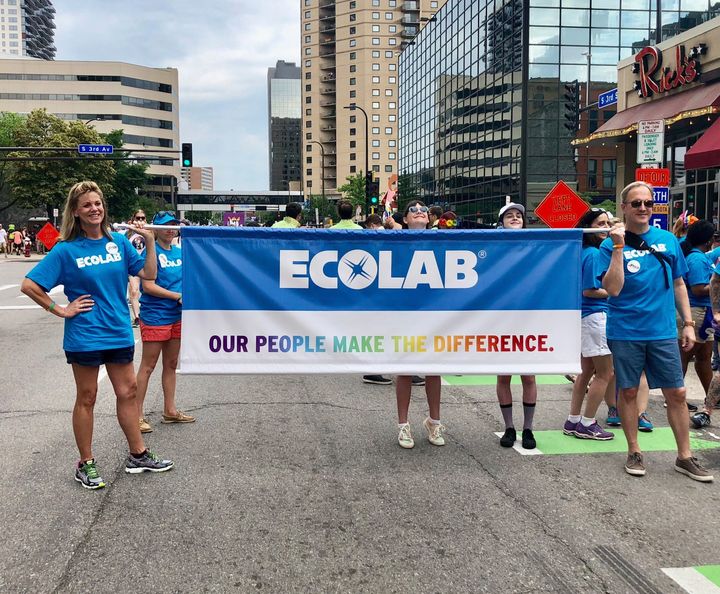
By Douglas M. Baker, Jr., chairman and CEO, Ecolab Inc.
We know that diversity and inclusion are vital to a company’s long-term health and growth. The research is clear: diverse companies substantially outperform their non-diverse peers. And millennials, who are already a third of our workforce, expect us to get this right. As do our customers.
There is a compelling business case for diversity and inclusion – and it’s the right thing to do. All people on our planet want to feel that they matter. When they believe that’s true, the result is a whole lot of positive, creative energy.
We want people to think of Ecolab as a great place to work, for everyone – a place where all employees can learn and grow as they shape their careers, make an impact, and quickly see the importance of what they do. We’ve made attracting, retaining and developing talent (and by extension, diversity and inclusion) a central tenet of our strategic growth plan, and we reinforce our commitment with leaders and managers all the time.
In the last couple of years, we’ve picked up the pace significantly. Here are some of the tactics we’ve used in our journey that other companies can adopt in theirs:
Take a hard look and set clear expectations. At our annual management team meeting last fall, we highlighted progress toward our goals in diversity and inclusion but also told the unvarnished truth about improvement opportunities. For example, we want to do even more to pursue diverse candidate pools when hiring and continue increasing the diversity of our key role succession plans – something we tackled when we launched paid parental leave for U.S. employees. Leaders left the management meeting with a list of actions, knowing exactly what was expected of them when it comes to deliberately growing and managing our talent – including the expectation that they are practicing inclusion as they build diverse teams.
Keep score. I hold my team responsible for their business results, and that includes how well they are managing the company’s talent resources. If we want to grow, we need strong, diverse talent pipelines. This begins with our leadership team and the decisions we make today. To equip leaders, we rolled out new talent scorecards to help measure the health of our people resources and guide talent conversations as we plan for growth. With these new scorecards, diversity was front and center during our annual talent planning process this spring and helped show Ecolab’s progress in improving diversity in hires, promotions and retention.
Train and aim. We established an Executive Diversity and Inclusion Council last year and it’s off to a strong start, helping raise awareness and drive change. The council meets quarterly and is made up of senior business leaders from around the world. Together they’ve undergone intensive, experiential unconscious bias training, and they’ve mapped out our go-forward strategy, focusing first on delivering actionable tools and insights to targeted groups, then on sharing global success stories to drive awareness and inspire further action. Council members also sponsor our employee resource groups (ERGs) and will be directly involved in helping to start new chapters of our ERGs for diverse groups around the world, so we can grow their impact on creating inclusive workplaces.
Spread the word. To help global employees connect with our strategic plan for growth, we hold “Strat Chats,” Ecolab’s version of a TED Talk. The session last fall on unconscious bias was enormously successful and sparked interest in team members around the world. Since then, we’ve developed an easy way for leaders to hold their own unconscious bias workshops. Our North America Institutional businesses have embedded the training into their onboarding for new sales associates – and 40 unconscious bias sessions took place around the globe in just one week.
Shake up the boardroom. You can’t be a great company without a great board, and a board can’t be great without diversity of background, style, experience and gender. Ecolab’s board of directors is now 31 percent women – up from 8 percent in 2006. We believe the diverse perspectives of our board will continue to play an important role in our organization’s growth and performance.
Just like any company that’s been around for a long time, Ecolab has had to evolve as we’ve grown to stay competitive. So when people ask me how we’ve approached diversity and inclusion, I tell them we’ve been on the journey for a long time. We’ve learned a lot along the way, and we still have distance to travel.
That’s why I joined more than 450 other company leaders in signing a written commitment to advance workplace diversity, as part of the CEO Action for Diversity & Inclusion (CEO Action). Signing that pledge may seem like a bold declaration or a new beginning of some kind, but it’s actually reinforced our longstanding belief that the best teams ― the ones that win our customers’ business over and over and drive ongoing innovation ― must be diverse and inclusive.
I’m proud of the work we’re doing, and I’m eager to see what our diverse teams will accomplish in the months and years ahead, as we strive together to make the world cleaner, safer and healthier.
CEO Action for Diversity & Inclusion was spearheaded by PwC U.S. Chairman Tim Ryan.
